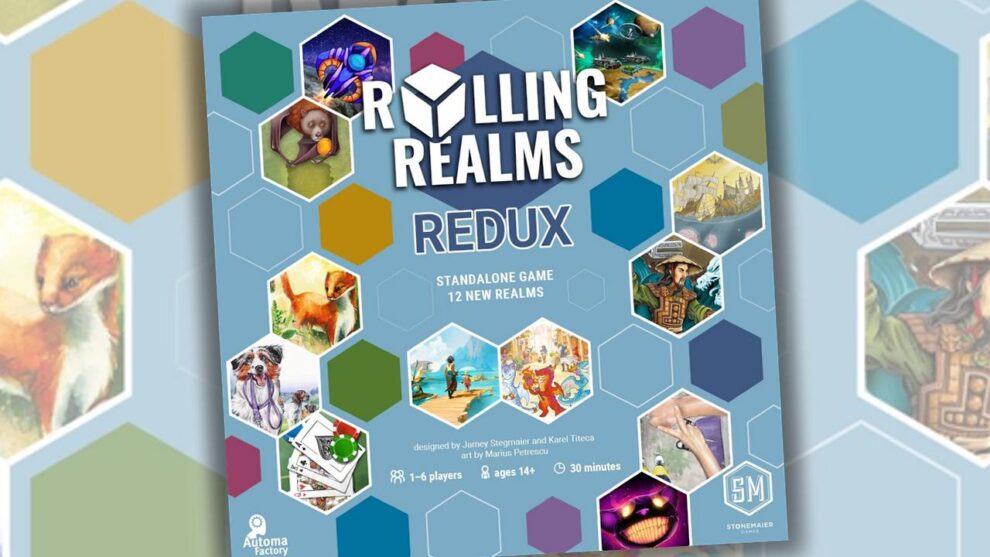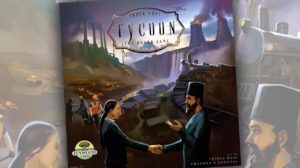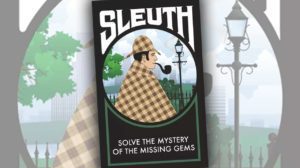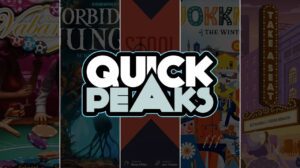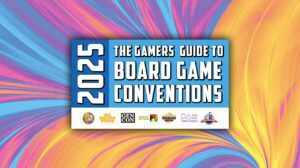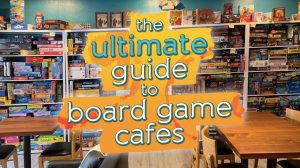Disclosure: Meeple Mountain received a free copy of this product in exchange for an honest, unbiased review. This review is not intended to be an endorsement.
I recently took my second trip into Rolling Realms land, with a multi-night spin through the 12 latest realms conceived for Rolling Realms Redux (2024, Stonemaier Games).
It’s a system that I enjoyed the first time around, especially after I realized that inviting friends to join me was a mistake. The first Rolling Realms could be played with an infinite number of players, as long as everyone had a deck of the Realms to write on, because everyone shares the same die roll.
Rolling Realms was conceived by Stonemaier head Jamey Stegmaier as a way to connect gamers via Facebook Live during the height of the pandemic. Rolling Realms Redux, then, is somewhat interesting as an anti-pandemic tool: now I only play games in person, instead of only playing them through a web browser.
To ensure I showed this to at least one of my game groups, I gathered members of my review crew for a four-player game of Rolling Realms Redux. Everyone, separately, enjoyed themselves—the Rolling Realms system is an interesting puzzle, no matter what Realms are in play.
But it’s weird to sit at a table with other players and basically not talk at all, right?

Pivot to Solo
Rolling Realms Redux (designed by both Stegmeier and Karel Titeca) is a 1-6 player roll-and-write game out of the box, with player counts that can scale up in multiples of six if your groups owns multiple copies of the game. The box says it takes about 30 minutes to play an entire game, but my multiplayer experiences with both the original game and this new “expandalone” addition tell me the real playtime is somewhere between 45-60 minutes.
Rolling Realms Redux (I’m tempted to refer to this as RRR moving forward, but that only makes me want to perform a “Naatu Naatu”-style dance-off with a rival) comes with 12 new Realms, with nine of them used in any one game. The format is the same as the base game: nine turns per round, three rounds, 27 total die rolls to score as many points as you can.
If you are new to the Rolling Realms system, check out my review of the base game. Now that there are a whopping SIXTY-SIX Realms available between the big box versions of the game and various promos and expansions, you can mix and match quite a few cards and almost never see the same three-Realm round structure twice.
A note about the dedicated solo mode, the RRR Ball Tournament—play it, even if you don’t typically like to play solo games. Designed by Titeca, Morten Monrad Pedersen, and Lieve Teugels, the RRR Ball Tournament has a ton of replayability and high score challenges if you find yourself in need of a campaign-style gaming activity, one that mimics Premier League soccer divisions and the way teams move up or down a tier based on their previous performance.
With five levels/leagues included in the solo mode, I found that even starting on the third level (recommended by the game for experienced Rolling Realms players) was a steep challenge depending on the nine turns in a round. It’s easy to tally the automa’s score and I was surprised to find that I went back to it for repeated plays.
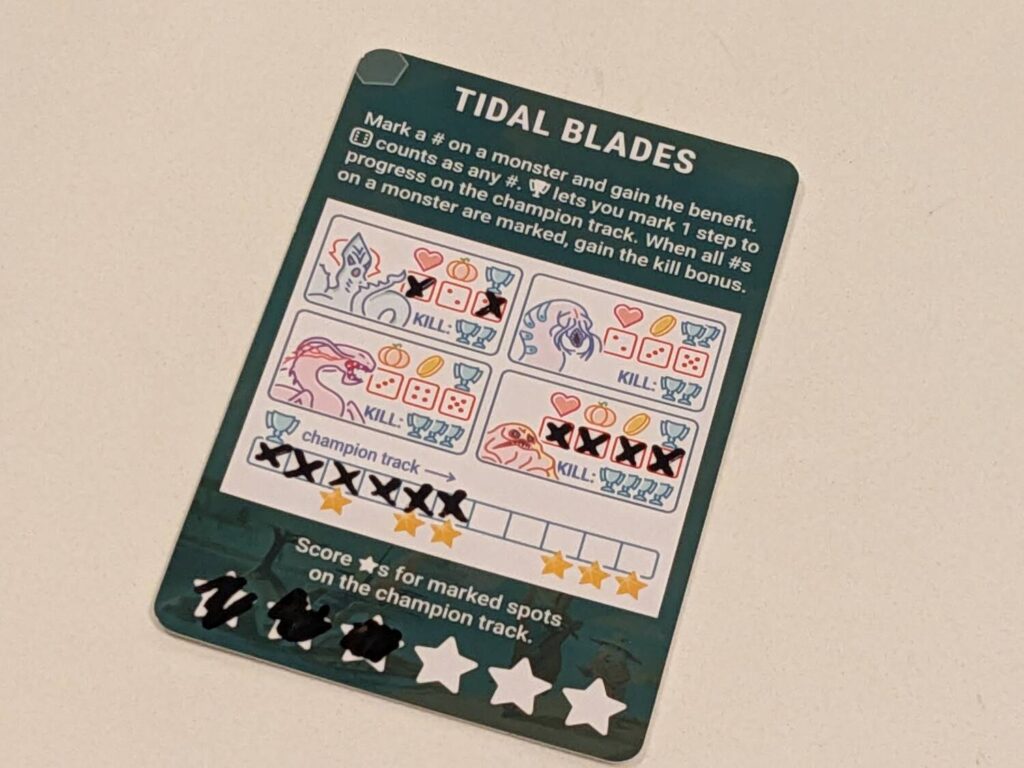
The Realms That Work
Eight of the 12 new Realms were fun for me, to the point where I quickly found myself shoving the other four aside to keep rolling with the new ones (pun intended).
Here are the Realms I enjoyed in this new set: Legacy of Yu, Wonderland’s War, Meadow, Dog Park, Tidal Blades, The Guild of Merchant Explorers, Planet Unknown, and Rock-Paper-Scissors. Most of my favorites had the easiest instructions, with one exception: I still don’t know why Rock-Paper-Scissors confused me and my playgroup so much during our first play!
Meadow and Dog Park are the most satisfying cards in this box, as it relates to the puzzles I enjoyed solving most. Getting that elusive bird in Meadow as the last stage of a star-scoring track was a strange-but-thrilling highlight near the eighth or ninth turn in a round. Legacy of Yu gave me a similar vibe—how can I slowly build a combo that allows me to end the round with numbers that fit neatly into ascending order to score six stars?
Tidal Blades was a silly one—it didn’t really feel like the tabletop version of the game at all, but I loved the cute monster pictures and the idea that killing a Jabba the Hut lookalike would net the most movement on a star-scoring track. Planet Unknown, like the board game, was a fun Tetris-style exercise—how can I max out this map while also playing the numbers game required to satisfy the formulas at the top of the card? Planet Unknown is also the Realm I still haven’t solved as a six-star solution (the max score in a round).
I enjoyed Rock-Paper-Scissors, but only after my first play. For some reason, I wish that the three shapes were pictures and not hand-drawn figures. I just couldn’t grok the idea that the X was used for scissors until I stood back from the card and realized how silly it was that I couldn’t make the “circle represents rock” visual computations work in my small noggin. Once I got there, that card was fabulous—I get to select one number to drop over here, and the other rolled number over there, and sometimes that would net a star on the same turn, while in other cases I needed to wait.

The Realms That Didn’t Work
The remaining four Realms—Atiwa, Poker, Flamecraft and Spaceshipped—left at least a little to be desired.
Poker was the biggest offender here, in part because in a world with 1,500 new tabletop games coming out each year, I was surprised that Poker was one of the games included in this set. (Strangely, I didn’t have this commentary about Rock-Paper-Scissors.) But the poker game I was playing just didn’t line up with the real-life poker I wanted to play. It also has a lot of instructions. Everyone got something wrong, rules-wise, on this Realm during our first play, and while these were corrected during successive solo plays, I just never got into the Poker Realm.
Spaceshipped felt broken to me, both during our multiplayer game and during one solo play—each time a player had a 1, 4, or 6, they used that to score the 11 that was needed to earn a star. (This realm is broken into sets, with two numbers that carry over from previous sets, and a total between 11-13 in a set earns a star.) Everyone scored six stars on the Spaceshipped Realm…and usually, getting six stars is difficult. There just wasn’t a puzzle with this Realm, which made it feel too easy.
Atiwa and Flamecraft just didn’t raise the tension level. (Sadly, this was also true with my experience playing the tabletop versions of both Atiwa and Flamecraft.) The Flamecraft Realm still boggles me a bit…it seems hard and somewhat wasteful to try and “six star” that Realm because of the conditions tied to writing numbers on the shops. One of the shops, which offers a bonus of writing an additional number in another shop, feels categorically more important than the others, so focusing on dropping 3s, 4s, and 5s in that shop of the Flamecraft Realm felt like the preferred path.
Atiwa? Another Realm that felt like the investment wouldn’t match the payoff, likely ending in four- or five-star range but taking real effort to get there.

More is More
If you already have the Rolling Realms base game and, say, a third of the 66 available Realms already in your collection, I’m not sure you should run out and buy another box’s worth of new Realms with Rolling Realms Redux. If, however, you are a solo player looking for a beefy new way to play alone outside of the standard scoring system, absolutely give Rolling Realms Redux a look.
Rolling Realms Redux will stay in my collection as a quiet solo activity after the kids go to bed. I still love rolling those sweet, chunky dice. And while I still hate the fact that the dry-erase pens don’t have an eraser on the end—instead asking players to use the separate, included wipe—the puzzles here are rich and mostly require crafty management of specific die rolls and the bonus resources (pumpkins, hearts, coins) to succeed.
The Rolling Realms system appears endless, and I’d be surprised if this is the last set we see in this game world. The designers keep finding creative ways to distill all manner of games into a single roll-and-write card, so I’ll keep playing them as long as Stonemaier keeps printing them!


